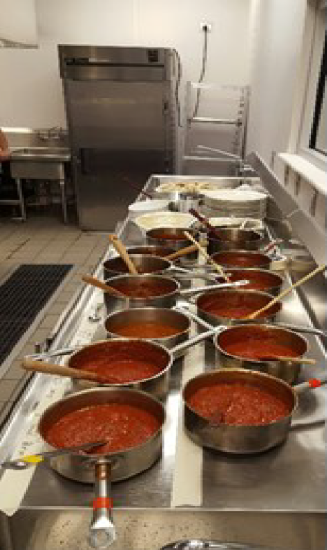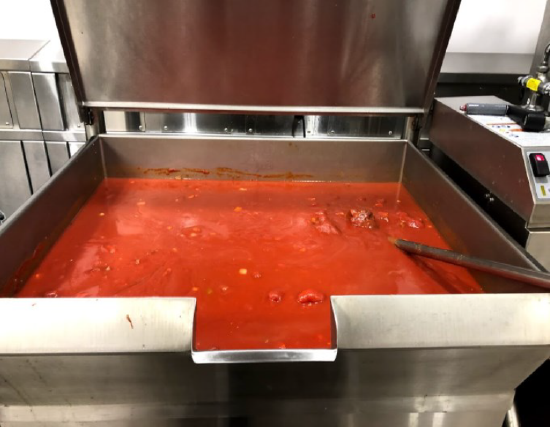1.7: Tomato Based Sauces
- Page ID
- 21156
\( \newcommand{\vecs}[1]{\overset { \scriptstyle \rightharpoonup} {\mathbf{#1}} } \)
\( \newcommand{\vecd}[1]{\overset{-\!-\!\rightharpoonup}{\vphantom{a}\smash {#1}}} \)
\( \newcommand{\id}{\mathrm{id}}\) \( \newcommand{\Span}{\mathrm{span}}\)
( \newcommand{\kernel}{\mathrm{null}\,}\) \( \newcommand{\range}{\mathrm{range}\,}\)
\( \newcommand{\RealPart}{\mathrm{Re}}\) \( \newcommand{\ImaginaryPart}{\mathrm{Im}}\)
\( \newcommand{\Argument}{\mathrm{Arg}}\) \( \newcommand{\norm}[1]{\| #1 \|}\)
\( \newcommand{\inner}[2]{\langle #1, #2 \rangle}\)
\( \newcommand{\Span}{\mathrm{span}}\)
\( \newcommand{\id}{\mathrm{id}}\)
\( \newcommand{\Span}{\mathrm{span}}\)
\( \newcommand{\kernel}{\mathrm{null}\,}\)
\( \newcommand{\range}{\mathrm{range}\,}\)
\( \newcommand{\RealPart}{\mathrm{Re}}\)
\( \newcommand{\ImaginaryPart}{\mathrm{Im}}\)
\( \newcommand{\Argument}{\mathrm{Arg}}\)
\( \newcommand{\norm}[1]{\| #1 \|}\)
\( \newcommand{\inner}[2]{\langle #1, #2 \rangle}\)
\( \newcommand{\Span}{\mathrm{span}}\) \( \newcommand{\AA}{\unicode[.8,0]{x212B}}\)
\( \newcommand{\vectorA}[1]{\vec{#1}} % arrow\)
\( \newcommand{\vectorAt}[1]{\vec{\text{#1}}} % arrow\)
\( \newcommand{\vectorB}[1]{\overset { \scriptstyle \rightharpoonup} {\mathbf{#1}} } \)
\( \newcommand{\vectorC}[1]{\textbf{#1}} \)
\( \newcommand{\vectorD}[1]{\overrightarrow{#1}} \)
\( \newcommand{\vectorDt}[1]{\overrightarrow{\text{#1}}} \)
\( \newcommand{\vectE}[1]{\overset{-\!-\!\rightharpoonup}{\vphantom{a}\smash{\mathbf {#1}}}} \)
\( \newcommand{\vecs}[1]{\overset { \scriptstyle \rightharpoonup} {\mathbf{#1}} } \)
\( \newcommand{\vecd}[1]{\overset{-\!-\!\rightharpoonup}{\vphantom{a}\smash {#1}}} \)
\(\newcommand{\avec}{\mathbf a}\) \(\newcommand{\bvec}{\mathbf b}\) \(\newcommand{\cvec}{\mathbf c}\) \(\newcommand{\dvec}{\mathbf d}\) \(\newcommand{\dtil}{\widetilde{\mathbf d}}\) \(\newcommand{\evec}{\mathbf e}\) \(\newcommand{\fvec}{\mathbf f}\) \(\newcommand{\nvec}{\mathbf n}\) \(\newcommand{\pvec}{\mathbf p}\) \(\newcommand{\qvec}{\mathbf q}\) \(\newcommand{\svec}{\mathbf s}\) \(\newcommand{\tvec}{\mathbf t}\) \(\newcommand{\uvec}{\mathbf u}\) \(\newcommand{\vvec}{\mathbf v}\) \(\newcommand{\wvec}{\mathbf w}\) \(\newcommand{\xvec}{\mathbf x}\) \(\newcommand{\yvec}{\mathbf y}\) \(\newcommand{\zvec}{\mathbf z}\) \(\newcommand{\rvec}{\mathbf r}\) \(\newcommand{\mvec}{\mathbf m}\) \(\newcommand{\zerovec}{\mathbf 0}\) \(\newcommand{\onevec}{\mathbf 1}\) \(\newcommand{\real}{\mathbb R}\) \(\newcommand{\twovec}[2]{\left[\begin{array}{r}#1 \\ #2 \end{array}\right]}\) \(\newcommand{\ctwovec}[2]{\left[\begin{array}{c}#1 \\ #2 \end{array}\right]}\) \(\newcommand{\threevec}[3]{\left[\begin{array}{r}#1 \\ #2 \\ #3 \end{array}\right]}\) \(\newcommand{\cthreevec}[3]{\left[\begin{array}{c}#1 \\ #2 \\ #3 \end{array}\right]}\) \(\newcommand{\fourvec}[4]{\left[\begin{array}{r}#1 \\ #2 \\ #3 \\ #4 \end{array}\right]}\) \(\newcommand{\cfourvec}[4]{\left[\begin{array}{c}#1 \\ #2 \\ #3 \\ #4 \end{array}\right]}\) \(\newcommand{\fivevec}[5]{\left[\begin{array}{r}#1 \\ #2 \\ #3 \\ #4 \\ #5 \\ \end{array}\right]}\) \(\newcommand{\cfivevec}[5]{\left[\begin{array}{c}#1 \\ #2 \\ #3 \\ #4 \\ #5 \\ \end{array}\right]}\) \(\newcommand{\mattwo}[4]{\left[\begin{array}{rr}#1 \amp #2 \\ #3 \amp #4 \\ \end{array}\right]}\) \(\newcommand{\laspan}[1]{\text{Span}\{#1\}}\) \(\newcommand{\bcal}{\cal B}\) \(\newcommand{\ccal}{\cal C}\) \(\newcommand{\scal}{\cal S}\) \(\newcommand{\wcal}{\cal W}\) \(\newcommand{\ecal}{\cal E}\) \(\newcommand{\coords}[2]{\left\{#1\right\}_{#2}}\) \(\newcommand{\gray}[1]{\color{gray}{#1}}\) \(\newcommand{\lgray}[1]{\color{lightgray}{#1}}\) \(\newcommand{\rank}{\operatorname{rank}}\) \(\newcommand{\row}{\text{Row}}\) \(\newcommand{\col}{\text{Col}}\) \(\renewcommand{\row}{\text{Row}}\) \(\newcommand{\nul}{\text{Nul}}\) \(\newcommand{\var}{\text{Var}}\) \(\newcommand{\corr}{\text{corr}}\) \(\newcommand{\len}[1]{\left|#1\right|}\) \(\newcommand{\bbar}{\overline{\bvec}}\) \(\newcommand{\bhat}{\widehat{\bvec}}\) \(\newcommand{\bperp}{\bvec^\perp}\) \(\newcommand{\xhat}{\widehat{\xvec}}\) \(\newcommand{\vhat}{\widehat{\vvec}}\) \(\newcommand{\uhat}{\widehat{\uvec}}\) \(\newcommand{\what}{\widehat{\wvec}}\) \(\newcommand{\Sighat}{\widehat{\Sigma}}\) \(\newcommand{\lt}{<}\) \(\newcommand{\gt}{>}\) \(\newcommand{\amp}{&}\) \(\definecolor{fillinmathshade}{gray}{0.9}\)The Tomato Sauce Family
The use of tomato sauce with pasta appears for the first time in 1790 in the Italian cookbook L'Apicio moderno, by Roman chef Francesco Leonardi. Tomato sauce (also known as Neapolitan sauce, or salsa di pomodoro in Italian) can refer to a large number of different sauces made primarily from tomatoes, usually to be served as part of a dish, rather than as a condiment. Tomato sauces are common for meat and vegetables, known as bases for Mexican salsas or sauces for pasta dishes, and have a rich flavor, high water content, soft flesh which breaks down easily, and the right composition to thicken into a sauce when they are cooked (without the need of thickeners such as roux). All of these qualities make them ideal for simple and appealing sauces. Classic tomato sauce is made from tomatoes, vegetables, seasonings and white stock and thickened with a blond or brown roux. In today's kitchens, however, most tomato sauces are not thickened with roux. Rather, they are created from tomatoes, herbs, spices, vegetables and other flavoring ingredients simmered together and pureed.
A gastrique is sometimes added to reduce the acidity of a tomato sauce. To prepare a gastrique, caramelize a small amount of sugar, then thin or deglaze with vinegar. This mixture is then used to finish the tomato sauce.
A properly made tomato sauce is thick, rich and full-flavored. Its texture should be grainier than most other classic sauces, but it should still be smooth. The vegetables and other seasonings should add flavor, but none should be pronounced. Tomato sauce should not be bitter, acidic or overly sweet. It should be deep reel and thick enough to cling to foods.
Yield: 1 gal. (4 lt)
- Salt pork, small dice 4 oz. (120 g)
- Mirepoix 1 lb. 8 oz. (750 g)
- Tomatoes, fresh or canned 3 qt. (3 lt)
- Tomato puree 2 qt. (2 lt)
Sachet
- Dried thyme 1 tsp. (5 ml)
- Bay leaves 3 (3)
- Garlic cloves 3 (3)
- Parsley stems 10 (10)
- Peppercorns, crushed ½ tsp. (3 ml)
- Salt l ½ oz. (45 g)
- Granulated sugar ¾ oz. (20 g)
- White stock 3 qt. (3 lt)
- Pork bones 2 lb. (1 kg)
- Render the salt pork over medium heat.
- Add the mirepoix and sauté, but do not brown.
- Add the tomatoes, tomato puree, sachet, salt and sugar.
- Add the stock and bones.
- Simmer slowly for 1 to 2 hours or until the desired consistency has been reached.
- Remove the bones and sachet and pass the sauce through a food mill. Cool in a water bath and refrigerate.
Small Tomato Sauces
The following small sauces arc made by adding the listed ingredients to 1-quart (1 liter) tomato sauce. The final step for each recipe is to season to taste with salt and pepper.
Creole
Sauté 6-ounces (170 grams) finely diced onion, 4-ounces (120 grams) thinly sliced celery and 1-teaspoon (5 milliliters) garlic in 1 fluid ounce (30 milliliters) oil. Add tomato sauce, a bay leaf and 1 pinch thyme; simmer for 15 minutes. Then add 4-ounces (120 grams) finely sliced green pepper and a clash of hot pepper sauce; simmer for 15 minutes longer. Remove the bay leaf.
Spanish
Prepare creole sauce as directed, adding 4 ounces (120 grams) sliced mushrooms to the sautéed onions. Garnish with sliced black or green olives.
Milanaise
Sauté 5 ounces (140 grams) sliced mushrooms in 1/2 ounce 05 grams) whole butter. Incorporate the tomato sauce and then stir in 5-ounces (140 grams) cooked ham (julienne) and 5 ounces (140 grams) cooked tongue (julienne). Bring to a simmer.


Tomato sauce production. Photo Credit: Amelie Zeringue


